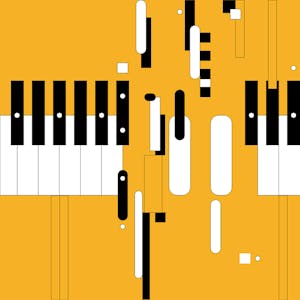This course is about how music works. It is about the relationship between the technical and aesthetic details of music. It is also about how developing a meaningful theoretical vocabulary can help you think and talk about musical style, and how learning that vocabulary can expand your appreciation for music.In this course you will learn music theory not by looking at theory itself, but by listening to, looking at, and—yes!—writing your own musical examples. By hearing, seeing, and writing yourself, you will learn about classical, modern, ancient, pop, jazz, and folk styles.
Through lectures, relevant examples, and numerous practice assignments, we will examine fundamental aspects of melody. We will move into working with two voices and counterpoint, and finally to three voices and the beginnings of harmonic function.
This is an intermediate-level course for musicians and composers who already have some understanding of music theory through previous study. If you are a musician or composer looking to build a deeper understanding of music theory for composing, performing, or improvisation, you have come to the right place. If you are an amateur lover of music or, perhaps, play a musical instrument and want to develop a deeper sense of appreciation for music theory, aesthetics, and history, you are also in the right place!
Analyze the relationship between the technical details and aesthetics of music.
Explore how culture, psychology, physics, formal context, and a sense of play all shape musical language.
Discover ways in which music theory may be relevant to enjoying, communicating a love for, and performing music.
Demonstrate confidence in the kind of musical self-analysis that can help you develop your own musical ideas.
Syllabus
Syllabus - What you will learn from this course
Week 1
Course Overview
Melodic Structures: Lines, Shapes, and Simple Modes
Week 2
Melodic Structures: Simplicity, Repetition, and Change
Week 3
Combining Pitches: Consonance and Dissonance
Week 4
Cadences and Basic Harmonic Function
FAQ
When will I have access to the lectures and assignments?
Access to lectures and assignments depends on your type of enrollment. If you take a course in audit mode, you will be able to see most course materials for free. To access graded assignments and to earn a Certificate, you will need to purchase the Certificate experience, during or after your audit. If you don't see the audit option:
What will I get if I purchase the Certificate?
When you purchase a Certificate you get access to all course materials, including graded assignments. Upon completing the course, your electronic Certificate will be added to your Accomplishments page - from there, you can print your Certificate or add it to your LinkedIn profile. If you only want to read and view the course content, you can audit the course for free.
Is financial aid available?
Yes. In select learning programs, you can apply for financial aid or a scholarship if you can’t afford the enrollment fee. If fin aid or scholarship is available for your learning program selection, you’ll find a link to apply on the description page.
Reviews
This was a very interesting and enjoyable course. I definitely know more about music know than when I started.
I'm Chinese, and not good at English. But with a dict in my hand, I enjoyed a lot in this course. Thanks the teacher very much.
I appreciate the ability to take this course on line. It was difficult but rewarding.
.
I learned so much in the course. Marc is a fantastic instructor. I never thought I could compose all these different styles of music!
